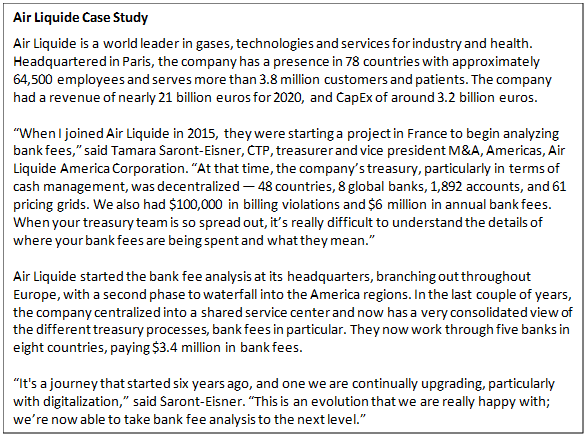Articles
Making the Case for Bank Fee Analysis
- By AFP Staff
- Published: 1/12/2022
While it may not be our favorite aspect of treasury management, the fact is bank fee analysis has a very high ROI. However, the difficulty of it, primarily fueled by outdated systems, has too often stymied even the most zealous treasurer from making it happen.
At AFP 2021, two treasury experts took on the subject of bank fee analysis, helping participants see not only the benefits, but also the history, global implications — and the way forward. Following are some of the highlights from this illuminating session.
Why bank fee analysis is so difficult
On the surface, bank fee analysis sounds like an easy task. But at the end of the day, we’d probably all agree that analyzing bank fees is anything but. In fact, it’s pretty difficult for two main reasons:
- Data collection. The data comes from a wide variety of sources and in many different forms, some of which are difficult to access. You could face a number – or all – of the following challenges: collecting historical statements, stacks of PDFs in read-only format, lack of fee statements, historical data stored in multiple sources, banks’ inability to create electronic files, no dynamic data, data classification issues, and no AFP codes on statements.
- Understanding the data. To understand the data, you need to ask three questions: What is this service? Who in my organization is using it? And why?
The accessibility of the data and the difficulty of getting into it is one of the main reasons why people don't get into it. But there is a solution for that. “If you're in the U.S., make sure you're receiving an EDI 822. Those are the electronic reports that banks provide, which solves that first problem. You can always ask for Excel if they don't produce it, but the likelihood is that you're going to be able to get it,” said Bridget Meyer, CTP, senior director, Redbridge Analytics.
The second problem, understanding the data, is its own challenge. If you don't know what it is, you will never be able to understand your service lines and your bank fee analysis. You need to ask three questions: what are these services, who is using them in my organization, and why. With those questions answered, you open up the lines of communication and build bridges between different departments.
The critical part AFP service codes© play
AFP service codes are the dictionary of cash management. If you are a brand-new to treasury, the first thing you should be reading over are the AFP code definitions. Because if you read through those, you will understand every service that banks provide. It's literally the playbook.
This is not a new topic; AFP codes have been around since 1986 and are updated regularly. There is a separate code set for global, established in 2012; if you have international accounts, your software will need to account for that. You will find AFP codes on most major banks’ PDF statements. They are the billing codes, just like the healthcare industry has. These codes are the critical foundation for any analysis, enabling us to do an anonymized RFP and to understand the services charged.
That said, banks haven't updated their AFP code assignments in years. And it's only going to get worse now that we have the 2020 codes. If you've tried to do this exercise, you're going to see a code that's all nines because it's a mandatory field and an EDI file, so you get some product managers out there who code something 999999 and think they’ve done their job.
It’s shocking that you could have a 50% difference in your code assignment — between a bank-reported AFP code versus a corrected AFP code. “If I'm releasing an RFP to those same banks, and they've mapped these codes this way, then the bank is interpreting those on the other side, and they have completely wrong AFP codes, you have a recipe for a lot of nasty surprises,” said Meyer. “It's really important that you do that analysis, because there’s a lot that can be lost in translation.”
This was the biggest AFP service code update in history
As the world was shutting down in 2020, AFP was getting ready to kick off its task force. We had 20 bankers and vendors and corporates lined up to look at the current treasury landscape and make sure that the code set was relevant. “The fun part about volunteering for these task forces is that you get to learn a lot about the treasury industry and what your peers are doing,” said Meyer.
Only 32% of the codes remained unchanged, and 100% of product groups changed. Here are the primary changes you need to know about:
- New product families were added for trade finance and integrated funds transfer services - integrated payables and receivables.
- New codes were added for RTP and all forms of instant payments.
- Banks are moving toward more centralized image platforms for reporting of images, so multiproduct imaging codes were added to the code set.
- Banks are starting to figure out how to charge for API transmission of data, so the new code set clarifies how these services should be mapped.
“The last time the code set was updated was 2013. When you think about the treasury landscape of 2013 versus today — big changes,” said Meyer.
All of the product groups changed. The largest product family, 10 Depository Services, had major modifications in the AFP 2020 code set to better reflect today’s cash vault and image deposit environment. Even core products that you may think haven’t really changed, have undergone major changes in the last couple of years.
Codes are not just for cash management anymore
Task force members met with subject-matter experts in retained assets, payment cards, trade, debt and credit, and custody services to ensure that whoever chooses to use these codes internally for data analytics, pricing exercises, or externally for an RFP or account analysis, has the best options available to reflect today’s treasury environment. There is now an industry standard code for every product that you could use with your bank. Most are only reporting cash management, but that doesn't mean those standards don't exist.
Banks need to update soon to avoid confusion in the market. “It's about the technology and hooking everything in on the backend for the bank side to make that happen,” said Meyer. “If that is your dream too, as a corporate, ask your banks for it.”
And be sure to ask your banks what version of AFP codes they're using. If you do a bank fee analysis, ask them to update to the 2020 set, or it's going to get really messy over the next couple of years, especially if you're trying to do an RFP.
The global story told from the BSB survey
The 2021 BSB survey confirms that after 10-plus years, the TWIST BSB bank billing format (camt.086) has reached the tipping point in global bank adoption. If you can't produce this file, and you are a bank, you are now late to the party. Corporates are expecting it, especially in certain regions. The good news is that the top five banks have most of the world covered; however, a large portion of Africa and the Middle East are still dead zones.
SWIFT is the most common delivery channel among European regional banks, but on a global scale, not all are prepared to offer this. Only 75% can do that from an FTP. Host-to-host (SFTP/FTPS), 100% of global banks choose this option, but only 40% can send it via SWIFT.
It’s a cultural difference. European regional banks all want to send files via SWIFT. In the U.S., it’s the opposite.
One of the other big things discovered through the survey results was in regard to historical data. Note: If you ever want to do a bank fee project, make sure you enroll today for electronic reporting. They can never go backward. Only one global bank has the ability to do so. If you decide one day that you want to do an RFP and need 12 months of historical data, you will not get it in an electronic format. You will get it in PDFs or in Excel, which will make the job that much more difficult.
Also of note, not all European banks with cash management in North America offer BSB reporting. The United States is not 100%, which is surprising, but that is because there are some European banks that participate in this that can't produce electronic bank fee reporting in the U.S., but they do basic cash management in the U.S.
Overall, holistically, the global banks are adopting this and really developing well. It's now time for the regional banks to get on board.
Cash management and BSB reporting are extensive in Europe, at about 80% for all countries. In Asia Pacific, a lot of the regional banks are starting to take action. In China, Singapore and Australia, you have a really good chance of getting data now. In Europe, thanks to some really active treasury organizations there putting pressure on these banks, almost all of the regional banks can now produce this file.
Benefits of bank fee analysis
Is it worth it? The answer is a resounding yes! Some of the benefits of bank fee analysis include:
- Cost analysis, control and reduction.
- Strengthens business unit and bank relationships.
- Visibility and accountability.
- Increases transparency into accounts, services and fees.
Bank fee data provides a record of the activities of your entire treasury, AR and AP functions, that can be used in endless ways to justify projects and to measure success. It really helps with cost allocation and reporting for quarter-end and month-end processes. “Practitioners tell me, ‘This used to take me days; it takes me five minutes now,” said Meyer.
It’s also great for projects, such as implementing a TMS, or quantifying the success of moving away from checks to electronic payments. You have all of the data right there to be able to prove how much money you saved your organization through that initiative. Determining the success of models and forecasts is an incredible application for this too.

“Our next step is understanding payment card fees,” said Saront-Eisner. “It is a very, very complex universe, between the acquiring, the processing, the merchant fees and in the U.S., import fees there are very high, but I think it's still like a black box. So, to go into the same type of unveiling and processing and understanding will help tremendously.”
What you can do right now
First, ask your banks to upgrade to AFP 2020, if they're not already. All accredited AFP banks should be updated and using the new codes as of January 1 of this year. Second, ask for your electronic bank files, if you're not getting them, because if you're ever ready to dive in, it's going to make your life a lot easier. Third, you will need a good bank analysis software, so start evaluating your options now. Fourth, confirm that your negotiated pricing has been applied. Fifth, remember that your banks are vendors, not partners; do your due diligence where they’re concerned.
PARTNER CONTENT
Copyright © 2025 Association for Financial Professionals, Inc.
All rights reserved.


.tmb-small.png?Culture=en&sfvrsn=3731146b_1)
